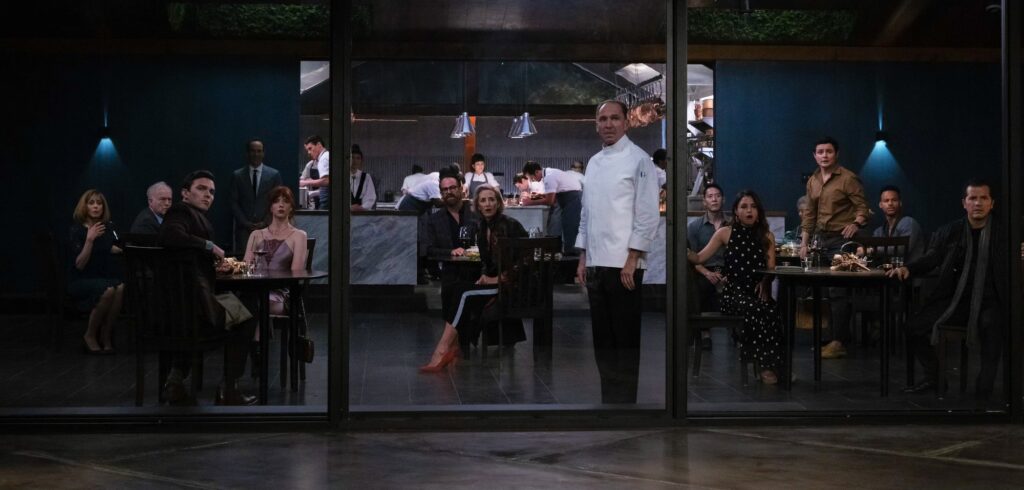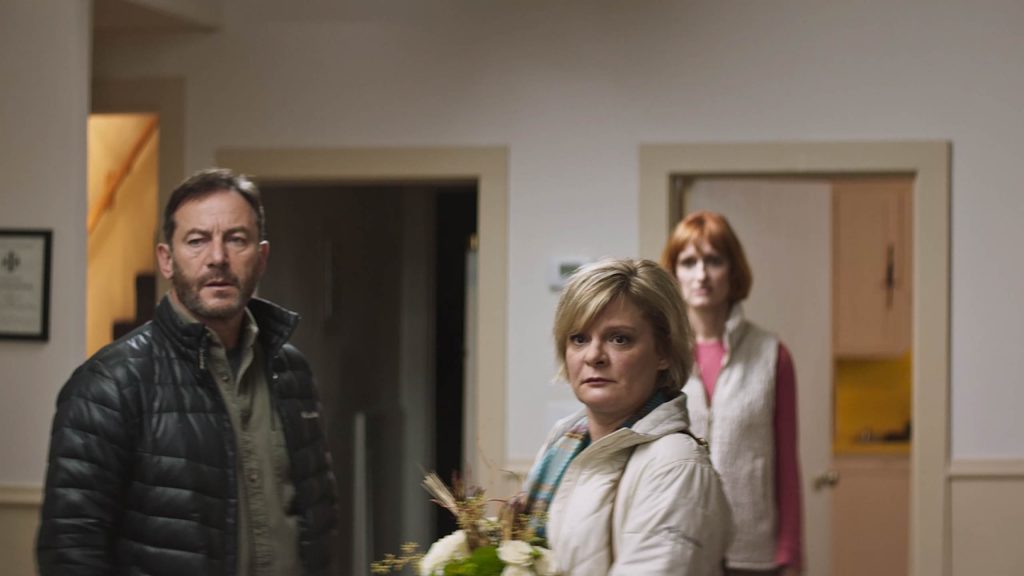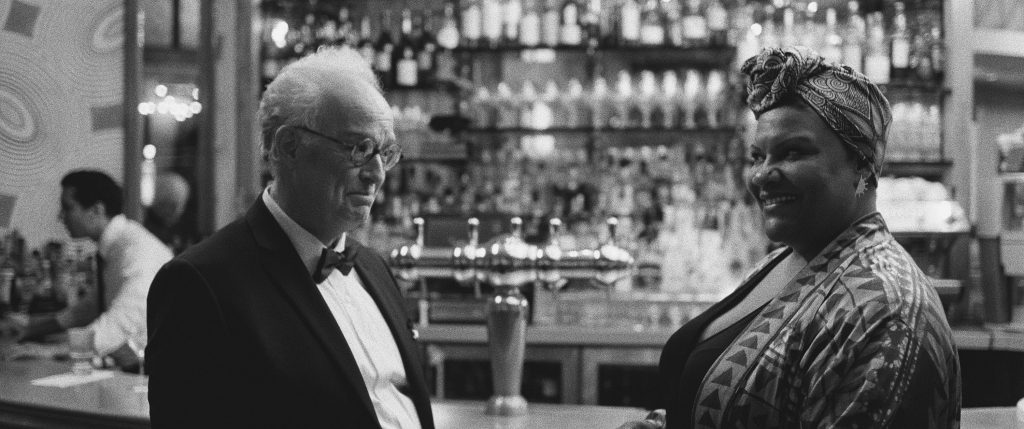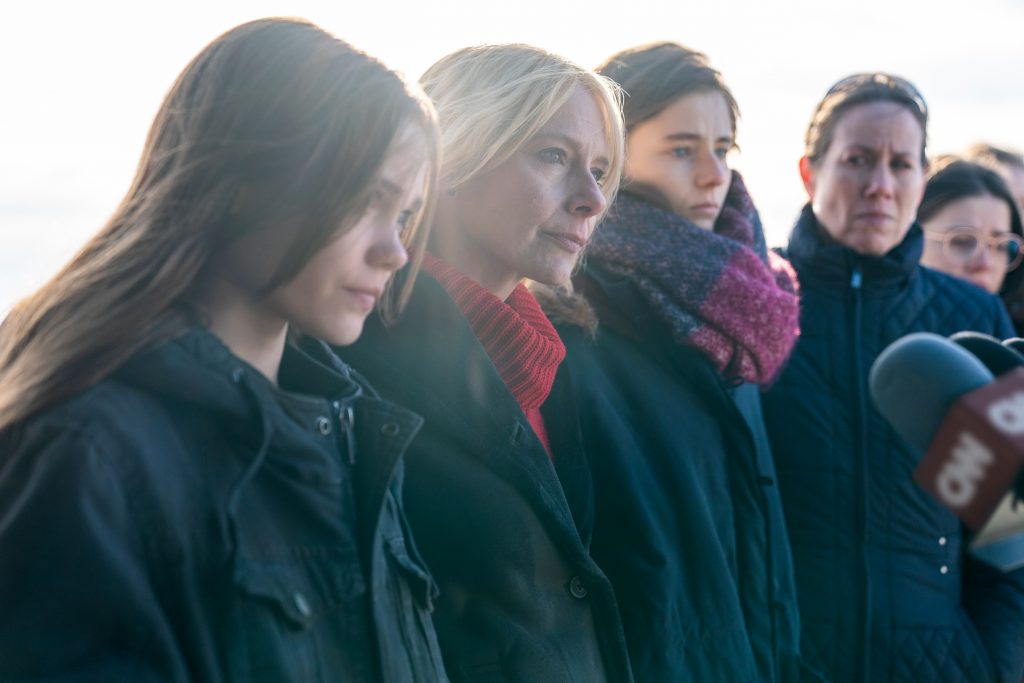April 15, 2023
by Carla Hay

Directed by Bess Wohl
Culture Representation: Taking place in upstate New York, the dramatic film “Baby Ruby” features a predominantly white cast of characters (with a few African Americans and Latinos) representing the working-class and middle-class.
Culture Clash: A popular lifestyle blogger experiences nightmarish scenarios soon after the birth of her first child.
Culture Audience: “Baby Ruby” will appeal primarily to people who are interested in watching incoherent and repetitive movies about postpartum depression.
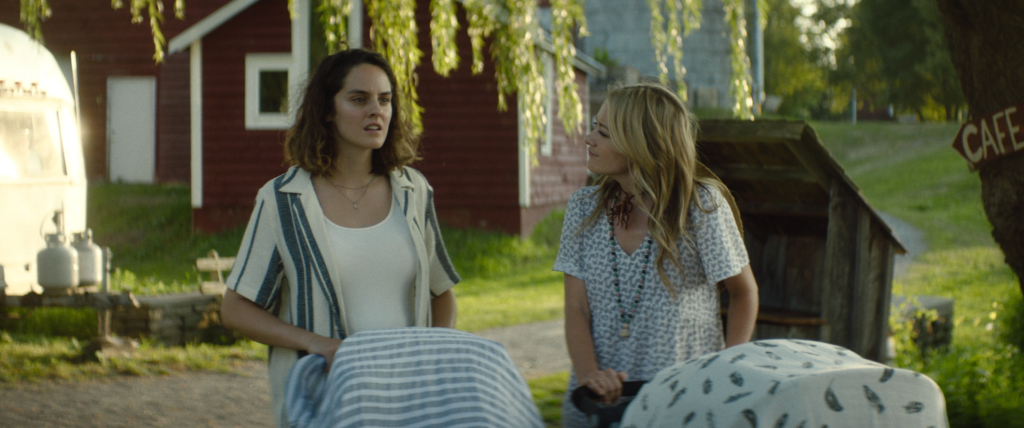
“Baby Ruby” wants to get viewers to think about postpartum depression, but this gimmicky and dull drama will just give some viewers a headache from all the baby screaming and mother’s hallucinations that the movie uses as weak filler. Before seeing “Baby Ruby,” some people might have the wrong impression that it’s a horror movie. “Baby Ruby” is more of a psychological drama that has nothing interesting to say and just shows a series of repetitive scenes of a new mother losing touch with reality. The movie’s ending is both annoying and underwhelming. “Baby Ruby” had its world premiere at the 2022 Toronto International Film Festival.
Written and directed by Bess Wohl, “Baby Ruby” (Wohl’s feature-film directorial debut) is inspired by Wohl’s experience with postpartum depression after the birth of her first child. In the “Baby Ruby” production notes, Wohl made this statement about this experience that describes, in part, how she was affected by being a first-time mother to a baby: “When I became a mother, I lost my mind … Suddenly, instead of floating on a cloud of oxytocin, I felt trapped in a nightmare. The doctors called my daughter ‘surprisingly alert’ which turned out to be code for fussy, sleepless, ravenous and insatiable. I had no idea how to soothe her; I couldn’t even soothe myself. My mind felt broken.”
Wohl’s statement continues: “My body felt like it was no longer my own. When I haltingly tried to tell people what I was experiencing, they assured me it was all ‘perfectly normal,’ and suggested that I just needed rest. But I couldn’t rest. I couldn’t calm down. I felt like I was dying, and, in a way, I was. Though I could never have articulated it at the time, what I was experiencing was the death of the person I had been before I had children.”
Those are perfectly valid feelings. The problem is that “Baby Ruby” is supposed to be a movie about postpartum depression, but the movie actually depicts someone going through the type of psychotic breakdown that doesn’t happen to most mothers—or to most people in general. The main conflict in “Baby Ruby” should have been more relatable to viewers, especially to those who’ve experienced postpartum depression. Instead, the movie goes so far off the deep end, it just becomes a very sloppy compilation of nightmarish visions.
In the beginning of “Baby Ruby,” protagonist Joséphine, nicknamed Jo (played by Noémie Merlant), is in her 30s and is about to give birth to her first child in less than a few weeks. Jo is a French immigrant living in an unnamed city in upstate New York. She is the owner of a women’s lifestyle blog called Love, Joséphine. The blog hasn’t made Jo rich, like Martha Stewart, but Jo is bringing in enough profits from the blog to live a comfortable, middle-class lifestyle.
Jo’s loving and supportive husband Spencer (played by Kit Harington), who is American, works as a butcher. Jo and Spencer have a solid marriage and are eagerly anticipating the birth of their first child. (Harington is British in real life, and he has a passable American accent in this movie.) Predictably, the marriage of Jo and Spencer becomes strained when Jo goes through her mental health issues after the baby is born.
The movie’s opening scene shows a baby shower party for Jo that is attended by about 10 to 15 of her work colleagues. Before the guests arrive, Jo is seen cutting these words out of felt material: “Welcome, Baby Ruby.” Spencer asks Jo if it’s weird that she’s throwing a baby shower for herself. Jo says no and adds, “It’s just because I need it to be perfect. It’s barely anything. Just people from work.” After the guests arrive, Jo’s assistant Caroline (played by Camila Canó-Flaviá) praises Jo as a “boss lady,” “entrepreneur” and “a leader.”
Caroline gushes to Jo, “You tripled our readership this year. You launched the online shop, you moved upstate, you did this insane renovation, by the way—all the while answering every single one of our readers’ comments personally. Oh, and by the way, making a human. We would all hate you if we didn’t absolutely love you. I feel so grateful to be a part of the Love, Joséphine family.”
Now that it’s been established that Jo is an overachiever and a bit of perfectionist, who seems to have an ideal life, it’s supposed to make it more unsettling for her when she feels she’s losing control over her life. “Baby Ruby” veers off course from the postpartum depression theme, in a scene where pregnant Jo goes to a store that sells baby clothes. While she’s looking at some of the merchandise, Jo notices a blonde woman staring at her.
The woman appears to be in the same age range as Jo. This mystery stranger asks Jo in a friendly tone when the baby is due. Jo tells her the due date is “any day now.” The woman then asks Jo, “Are you scared?” Jo replies, “Should I be?” The woman has a baby in a stroller. But when Jo asks to see the baby, the woman’s attitude becomes hostile. She pushes Jo’s hand away and says that sleeping babies shouldn’t be awakened.
A few days after this uncomfortable incident, Jo gives birth in a hospital to a healthy baby girl named Ruby (played by Gabriella Reese Thompson and Lucas Timothy Thompson). But more odd things start happening. At the hospital, Jo is told by an unnamed nurse (played by Mariela Villa) that Jo can’t leave the hospital until Jo has defecated. When Jo does that, Jo sees blood is in the toilet. And then, the nurse gives Jo the baby’s placenta, “in case you want to eat it,” says the nurse. Most people would say something to a medical professional at the hospital about these two strange incidents, but Jo says nothing.
During the car ride home, Jo hallucinates seeing a young mother on the street throwing her baby at the car. It’s one of those scenes that pretends to be “real,” but then viewers find out it was all in Jo’s mind. Get used to seeing more of these fakeout scenes in “Baby Ruby,” because this repetitively boring movie is full them.
“Baby Ruby” does not give details on how long Jo has been living in her current home, but she doesn’t have any friends in the neighborhood. Instead, Jo is irritated that the only person she might have for company while Spencer is away at work is Spencer’s meddling and overprotective mother Doris (played by Jayne Atkinson), who insists that Jo call her “Mom.” Doris isn’t mean-spirited, and she has good intentions, but it’s obvious that Doris expects Jo to do what Doris thinks Jo should do in taking care of Ruby, instead of respecting Jo’s parenting choices.
Not much is revealed about Jo’s side of the family, except for one comment that Jo makes when she and Spencer leave the hospital with Ruby: “I wish my mum were here.” In fact, one of the biggest flaws about “Baby Ruby” is there’s hardly anything revealed about Ruby and Spencer (other than their jobs) at all throughout this 93-minute film. Spencer just becomes a husband who reacts in stereotypical ways when his wife starts to have terrified reactions to things that other people can’t see.
That’s because most of this movie turns into a tired cliché of the “paranoid woman who is not believed,” which is very common in horror movies—except that “Baby Ruby” isn’t a horror movie. It’s a very superficial exercise in flimsy jump scares that are supposed to be manifestations of motherhood fears. Fans of Harington will be disappointed by how uninteresting his Spencer character is and how he isn’t in the movie as much as his co-headlining status for “Baby Ruby” would suggest.
Making matters worse, Jo and Spencer don’t do things that real couples do when they have a newborn baby in the home. They don’t talk about how they’re going to take turns getting the baby to go back to sleep at night when the baby wakes up screaming and crying. They don’t talk about who would take care of the baby if the baby’s parents and other relatives aren’t available. If Spencer has any friends, they are not seen or mentioned this movie. These are some of the many reasons why “Baby Ruby” looks so phony and unrelatable.
Instead of showing Jo and Spencer as a realistic couple, “Baby Ruby” wastes a lot of time on a subplot about the mystery blonde coming back into Jo’s life. It happens when Jo is outside with Ruby in a stroller, on a residential street. A car speeds by, causing the stroller to tip over. Luckily, Ruby isn’t hurt.
But the rude blonde from the baby clothing store is nearby and witnesses this incident. She sees Jo and starts talking to Jo, as if she doesn’t remember how unfriendly she was to Jo the previous time that they talked. Her name is Shelly (played by Meredith Hagner), who is also married. Shelly’s baby is her first child. Shelly and Jo end up striking up a friendship where Shelly introduces Jo to a group of other young mothers in the neighborhood.
The movie goes off on an unrelated tangent where Shelly and Jo end up being sexually attracted to each other and start kissing each other passionately after a drunken night at a bar. But did this makeout session really happen? Or was it all in Jo’s imagination? Does anyone really care? Viewers shouldn’t care, because it’s ultimately a useless subplot.
When Jo is not having blackouts or being confused about what reality is, she sees things like a bony hand trying to get to Ruby in the crib while Jo is looking at a baby monitor in another room. When Jo rushes into the crib room to protect Ruby, there is no menacing intruder, and Ruby is safe and sound. These are the types of unimaginative scenes that litter the movie and do nothing to further the story’s plot.
“Baby Ruby” also has a weak and poorly written subplot that tries to mislead viewers into thinking that Ruby might be a “demon baby.” Even though Ruby is a newborn, Jo painfully finds out something shocking when she’s breastfeeding the baby: Ruby has a full set of teeth that normally wouldn’t grow so fast in a child this young. Jo’s obstetrician Dr. Rosenbaum (played by Reed Birney) dismisses this biological abnormality and says it’s not a big deal. Jo doesn’t question his assessment. It’s all just another clue that something is very wrong with Jo, and it’s another one of her hallucinations.
Jo also gets pestered by her assistant Caroline to share a photo of Ruby with the audience of Love, Joséphine. Before Jo gave birth, Jo had been blogging about her pregnancy journey on the website and had promised her audience that she would share photos of the baby after the baby was born. However, Jo keeps delaying making any photos of Ruby available to the public.
Ruby is kept hidden from Jo’s audience, but the audience of “Baby Ruby” will get a full-blast onslaught of this kid’s crying and shrieking, which intentionally gets louder and more frequent the more that Jo becomes unhinged. It’s an obvious and lazy way of trying to make viewers feel like they’re “losing their minds” too, because this incessant baby crying is part of what is supposed to be driving Jo over the edge into insanity. All it does is give an inaccurate, insulting and extremely “hysterical” version of postpartum depression.
All of the characters in “Baby Ruby” except Jo are very generic, with performances to match. Merlant seems to be doing her best in attempting to convince viewers that Jo is a complicated and tortured person. But the results just don’t look authentic, because Jo is depicted as being frequently shallow and vapid. The movie also makes a somewhat offensive and flippant mockery of the necessary steps to have someone involuntarily committed to a psychiatric institution. “Baby Ruby,” just like Jo, ends up being a very muddled mess with absolutely no depth and nothing substantial to say.
Magnet Releasing released “Baby Ruby” in select U.S. cinemas, on digital and VOD on February 3, 2023.

